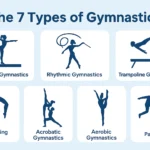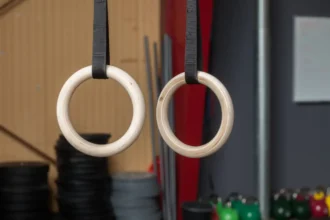Want to build a strong, wide back that stands out? Wide grip pull-ups are one of the best exercises to help you get that V-shaped look. They target your upper back and lats more than regular pull-ups and challenge your strength in a whole new way. In this guide, you’ll learn how to do them properly, why they’re so effective, and how to work your way up even if you can’t do one yet.
What Is a Wide Grip Pull-Up?
A wide grip pull-up is a variation of the traditional pull-up where your hands are placed farther apart than shoulder-width, using an overhand (pronated) grip. This positioning shifts emphasis away from the biceps and places more stress on the upper latissimus dorsi (lats), teres major, rear deltoids, and lower trapezius—muscles responsible for that broad “wingspan” appearance.
Key Features:
- Grip width: 1.5–2x shoulder width
- Grip type: Pronated (palms facing away)
- Movement plane: Vertical pull
- Target area: Upper lats and outer back
Muscles Worked
Wide grip pull-ups primarily target the following muscles:
| Muscle Group | Function |
|---|---|
| Latissimus Dorsi | Shoulder extension, adduction, and internal rotation |
| Teres Major | Assists the lats in pulling and shoulder movement |
| Trapezius (lower) | Stabilizes scapula during the pull |
| Rhomboids | Retracts and stabilizes scapula |
| Rear Deltoids | Assists in shoulder movement and stabilization |
| Biceps Brachii | Secondary support during elbow flexion |
| Core Muscles | Maintain body position and resist swing |
How Wide Should Your Grip Be?
Too wide and you reduce your range of motion, increase joint stress, and risk injury. Too narrow and you’re doing more of a standard pull-up. A good rule of thumb is:
- 1.5x shoulder width = balanced activation
- 2x shoulder width = maximal lat engagement but more difficult
Experiment conservatively to find a strong yet challenging width without compromising control.
How to Do Wide Grip Pull-Ups
Here’s a step-by-step guide on how to do wide grip pull-ups with proper form and technique:
1. Get Your Grip Right
Stand under a pull-up bar and reach up. Grab the bar with your hands wider than your shoulders—about 1.5 to 2 times wider. This is what makes it a “wide grip.”
Make sure your palms are facing away from you (this is called an overhand grip). Wrap your thumbs around the bar so your hands stay secure.
2. Hang and Tighten Your Body
Let your body hang straight from the bar. Your arms should be fully straight, and your feet can hang or cross behind you. This is called a dead hang.
Before you pull up, tighten your stomach, squeeze your shoulder blades down and back, and keep your chest lifted. This helps protect your shoulders and gets the right muscles ready to work.
3. Start Pulling Yourself Up
Begin the movement by pulling your elbows down and out. Try to bring your chest up toward the bar—not just your chin.
Keep your body steady. Don’t swing or use momentum. Pull with your back muscles, not just your arms.
4. Reach the Top
Keep pulling until your chin is above the bar or your upper chest is close to it. Don’t lift your chin just to cheat—use your muscles to get there.
Hold at the top for a second if you can.
5. Lower Yourself Slowly
Now lower your body back down with control. Your arms should go all the way straight at the bottom, but don’t let your shoulders shrug up.
Lowering slowly helps you get stronger and keeps you safe. Try not to drop too fast.
Helpful Tips
- Keep your core tight to avoid swinging.
- Pull your shoulders down before pulling up.
- Don’t rush—slow, clean reps are better than fast, sloppy ones.
- Go through the full motion—don’t cheat halfway.
How Many Should You Do?
If you’re new, start with assisted pull-ups or negatives (jump up, lower slowly) and aim for 3 to 5 reps per set. Once you’re stronger, try 3–4 sets of 5–8 reps. If that feels easy, you can add weight for more challenge.
Wide Grip Pull-Ups vs. Other Pull-Up Variations
Wide grip pull-ups are a fantastic way to build upper body strength, but how do they stack up against other common pull-up variations? Let’s take a look at the differences:
| Pull-Up Variation | Grip Position | Muscles Worked | Difficulty Level |
|---|---|---|---|
| Wide Grip Pull-Up | 1.5–2× shoulder-width (overhand) | Lats, traps, rhomboids, shoulders | Harder (due to leverage and shoulder stress) |
| Close Grip Pull-Up | Shoulder-width or narrower | Biceps, forearms, lats | Easier (more biceps help) |
| Neutral Grip Pull-Up | Palms facing each other | Lats, biceps, forearms, traps | Moderate (shoulder-friendly) |
| Standard Pull-Up | Shoulder-width (overhand) | Lats, biceps, traps, forearms | Moderate (balanced option) |
| Chin-Up | Shoulder-width (underhand) | Biceps, lats, forearms | Easier (biceps-dominant) |
| Commando Pull-Up | Hands close together, one in front of other | Lats, biceps, obliques, core | Harder (unilateral movement + core rotation) |
Why Are Wide Grip Pull-Ups Harder Than Other Variations?
Because your arms can’t help much, your shoulders and back work more, and your body has to stay super stable.
Wide Grip Pull-Ups vs. Close Grip Pull-Ups
Wide grip pull-ups have your hands placed farther apart, with palms facing away. They mainly work the lats and upper back, helping you build width and a V-shaped back. This variation is harder and puts more stress on the shoulders.
Close grip pull-ups use a narrower grip—shoulder-width or closer. They work the biceps, forearms, and lats, giving you more arm involvement and making the movement a bit easier. They’re also gentler on the shoulders.
In short:
- Use wide grip to build back width and upper back strength.
- Use close grip for more bicep activation and an easier pull-up variation.
Wide Grip Pull-Ups vs. Neutral Grip Pull-Ups
Wide grip pull-ups use a grip that’s wider than your shoulders, with palms facing away. They focus more on the upper back and lats, helping to build that broad, V-shaped look. However, they’re harder to do and can put more strain on your shoulders.
Neutral grip pull-ups use parallel handles with palms facing each other. They work both your back and arms more evenly and are easier on your shoulders and wrists. This grip is often more comfortable, especially for beginners or anyone with joint issues.
In short:
- Use wide grip to build a wider back and challenge your upper body.
- Use neutral grip for a balanced workout that’s easier on your joints.
Wide Grip Pull-Ups vs. Standard Pull-Ups
Wide grip pull-ups use a grip wider than shoulder-width. They focus more on the lats and upper back, helping you build a wider, V-shaped back. They’re more challenging and can put extra strain on the shoulders.
Standard pull-ups use a shoulder-width grip with palms facing away. They give you a balanced workout for your back, shoulders, and arms, and are easier to perform than the wide grip version.
In short:
- Use wide grip for more focus on your upper back and lat width.
- Use standard grip for a well-rounded upper body workout with less shoulder stress.
Here’s a simple explanation comparing wide grip pull-ups and chin-ups:
Wide Grip Pull-Ups vs. Chin-Ups
Wide grip pull-ups use a wide, overhand grip (palms facing away). They mainly work your upper back and lats and are great for building a broad back. They’re more difficult and use less bicep help.
Chin-ups use a close, underhand grip (palms facing you). They focus more on the biceps and are usually easier because your arms help more. They still work your back, but not as much as wide grip pull-ups.
In short:
- Choose wide grip to target your back and build width.
- Choose chin-ups to hit your biceps and make pulling easier.
Here’s a simple comparison between wide grip pull-ups and commando pull-ups:
Wide Grip Pull-Ups vs. Commando Pull-Ups
Wide grip pull-ups use a wide, overhand grip with both hands far apart. They target the lats, upper back, and shoulders. This grip is tough and helps build a wide, strong back.
Commando pull-ups use a narrow, mixed grip—one hand in front of the other on the bar. You pull your head up to one side of the bar, then alternate. This works biceps, forearms, lats, and core, and challenges your grip and balance.
In short:
- Use wide grip to focus on back width and upper-body strength.
- Use commando pull-ups for grip variety, core work, and arm strength.
Progressions & Modifications for Wide Grip Pull-Ups
If you’re not yet strong enough to do wide grip pull-ups, don’t worry. Several smart progressions will build the strength and control you need, step by step. Here’s how to safely work your way up:
Beginner Progressions
1. Dead Hangs
Hang from the bar with a wide grip. Focus on holding still. This builds grip strength and shoulder stability. Start with 10–20 seconds and slowly add time.
2. Scapular Pulls
Hang from the bar and gently pull your shoulder blades down and together—don’t bend your elbows. This activates the upper back muscles needed for pull-ups.
3. Assisted Pull-Ups (Bands or Foot Support)
Use a resistance band or place your feet on a box to make the pull-up easier. Keep the motion slow and controlled. Focus on using your back, not just your arms.
4. Negative Pull-Ups
Step or jump to the top of the bar, then slowly lower yourself over 3–5 seconds. This strengthens the pulling muscles even if you can’t lift yourself up yet.
5. Wide Grip Inverted Rows
Set a bar or rings at waist height. With your body straight, pull your chest up toward the bar using a wide grip. A great beginner-friendly pulling exercise.
Intermediate Modifications
1. Standard Pull-Ups
Build up to 8–10 solid shoulder-width pull-ups with good form. This gives you the base strength to move to wider grips.
2. Wide Grip Lat Pulldowns
If you have access to a cable machine, use a wide grip to mimic the pull-up movement. Keep the motion smooth and lead with your elbows.
3. Partial Range Pull-Ups
Can’t do the full movement yet? Just go halfway up or down. Slowly increase your range over time.
4. Isometric Holds
Hold yourself in place at the top, middle, or bottom of the pull-up for 10–20 seconds. Builds control and endurance.
Advanced Progressions
1. Full Wide Grip Pull-Ups
Start with 1–3 reps using strict form. Don’t worry about high reps—focus on quality.
2. Pause Reps
Pause for 1–2 seconds at the top or midpoint of each rep. This builds strength and removes momentum.
3. Tempo Pull-Ups
Slow the movement down: take 2 seconds to pull up and 3–5 seconds to lower down. The slower pace increases time under tension (and results!).
4. Weighted Wide Grip Pull-Ups
Once bodyweight wide grips feel easy, add a weight vest or dip belt. Start light and increase gradually.
✅ Final Tips
- Train wide grip pull-ups 2–3 times per week.
- Focus on form over reps—don’t rush.
- Always warm up your shoulders before starting.
- Make small progress each week—it adds up fast.
- And remember: even one clean wide grip pull-up is something to celebrate!
Use these progressions and stay consistent. You’ll be surprised how quickly your strength builds up.












